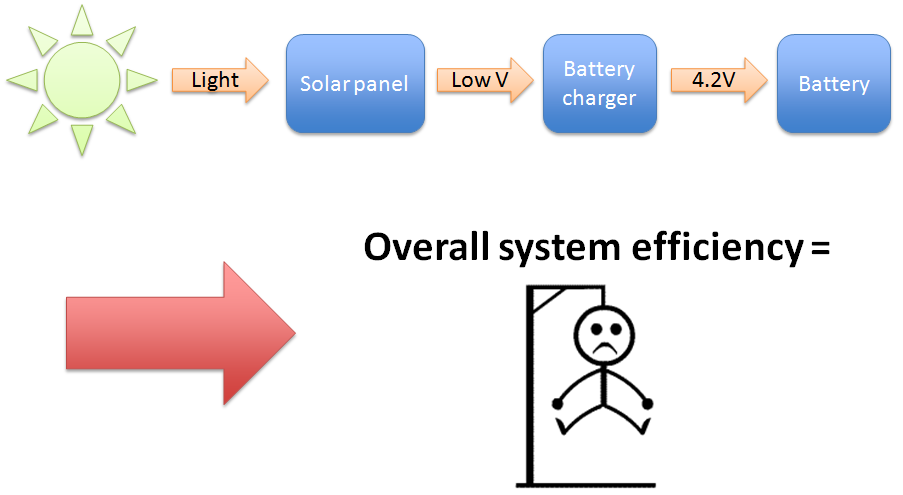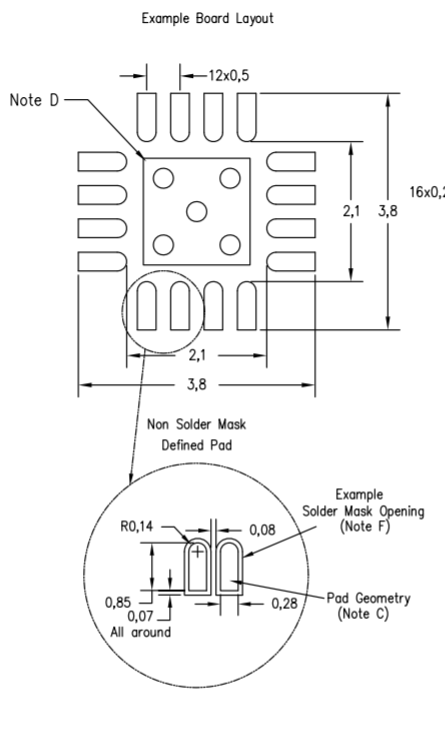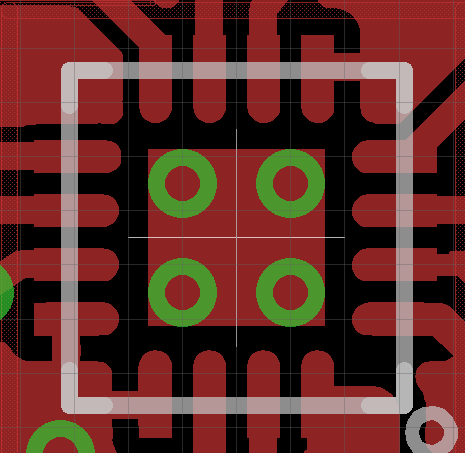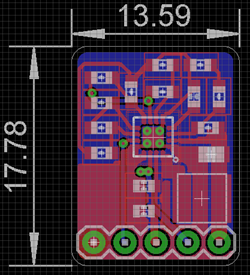Powering mote 24/7 using only a supercap and solar
-
Well, answering my own question, it looks as though there is at least one breakout board for it: https://www.tindie.com/products/onehorse/bq25504-solar-cell-lipo-charger/
Sticker shock though.Also, there's this breakout based on the LTC3108, but be prepared for sticker shock again: https://www.crispytronics.com/collections/energy-harvesting/products/energy-harvester-breakout-100-mv-startup?variant=882155101
-
yep i know these, look nice ;) all depends of the usecase like i said
-
I'm quite impressed with Digikey. I ordered the above parts on Tuesday (2 days ago), for just regular First Class mail delivery, and the parts arrived today already. Cool!
Anyhow, all these parts are so small that I'll need to create some custom breakout boards for each of them in order to do any testing. I do hope that regular tack and drag hand soldering works on parts this small. Otherwise, I'll have to build a reflow oven out of a toaster oven, and that might mean further delay.
-
@scalz said:
one of the best part i know for this is also the BQ25504. One of the most efficient i think.
I'm designing a board for solar ;) so i've studied a bit alternatives for my usecase.
Best is to fit an app, because there are always lot of dilemma and compromise regarding solar panel used, input voltage, effiency not always the same with MPPT, and cost...not so simple,
There are also multiple solar charger boards which exist like the adafruit or the lipo rider, more simple but can do the job too etc...
Lot of articles about this on internet too.
These low input voltage are nice, but it's not a big harvest. for indoor, with all packet exchange we have for a transmission can be critical. Then you can do battery extender etc.. but add cost.
For outdoor a bit easier, and perhaps does not need expensive ic to run etc..Yeah, the BQ25504 does appear to offer nice functionality. But at 3x3mm in size, I'm afraid it would be challenging to solder it. Is it available in a larger package or pre-soldered onto a breakout board?
@NeverDie said:
@scalz said:
one of the best part i know for this is also the BQ25504. One of the most efficient i think.
I'm designing a board for solar ;) so i've studied a bit alternatives for my usecase.
Best is to fit an app, because there are always lot of dilemma and compromise regarding solar panel used, input voltage, effiency not always the same with MPPT, and cost...not so simple,
There are also multiple solar charger boards which exist like the adafruit or the lipo rider, more simple but can do the job too etc...
Lot of articles about this on internet too.
These low input voltage are nice, but it's not a big harvest. for indoor, with all packet exchange we have for a transmission can be critical. Then you can do battery extender etc.. but add cost.
For outdoor a bit easier, and perhaps does not need expensive ic to run etc..Yeah, the BQ25504 does appear to offer nice functionality. But at 3x3mm in size, I'm afraid it would be challenging to solder it. Is it available in a larger package or pre-soldered onto a breakout board?
I've changed my mind. I want to try the BQ25504. Why? Well, it turns out a guy in Switzerland has already done more or less the experiment that I was going to do, and this is his conclusion:

(http://www.limpkin.fr/index.php?post/2011/12/07/Indoor-solar-energy-harvesting%3A-a-platform-to-(finally)-get-some-numbers)LOL. So, regardless of soldering difficulty, the BQ25504 looks like it's sufficiently better that it's worth pursuing.
However, TI's eval board for the BQ25504, is a totally insane $99. So, it's either DIY, or else find some other BQ25504 board that's priced more sensibly. There is one on Tindie that I've already mentioned (above). Any others worth considering?
-
@NeverDie said:
@scalz said:
one of the best part i know for this is also the BQ25504. One of the most efficient i think.
I'm designing a board for solar ;) so i've studied a bit alternatives for my usecase.
Best is to fit an app, because there are always lot of dilemma and compromise regarding solar panel used, input voltage, effiency not always the same with MPPT, and cost...not so simple,
There are also multiple solar charger boards which exist like the adafruit or the lipo rider, more simple but can do the job too etc...
Lot of articles about this on internet too.
These low input voltage are nice, but it's not a big harvest. for indoor, with all packet exchange we have for a transmission can be critical. Then you can do battery extender etc.. but add cost.
For outdoor a bit easier, and perhaps does not need expensive ic to run etc..Yeah, the BQ25504 does appear to offer nice functionality. But at 3x3mm in size, I'm afraid it would be challenging to solder it. Is it available in a larger package or pre-soldered onto a breakout board?
I've changed my mind. I want to try the BQ25504. Why? Well, it turns out a guy in Switzerland has already done more or less the experiment that I was going to do, and this is his conclusion:

(http://www.limpkin.fr/index.php?post/2011/12/07/Indoor-solar-energy-harvesting%3A-a-platform-to-(finally)-get-some-numbers)LOL. So, regardless of soldering difficulty, the BQ25504 looks like it's sufficiently better that it's worth pursuing.
However, TI's eval board for the BQ25504, is a totally insane $99. So, it's either DIY, or else find some other BQ25504 board that's priced more sensibly. There is one on Tindie that I've already mentioned (above). Any others worth considering?
Fortunately, I notice that the author of the Tindie product has posted his PCB on OSH PARK: https://www.oshpark.com/shared_projects/tksisJZ6 An order for 3 PCB's costs a total of just $1.25. Nice!
-
As for soldering the BQ25504 chip, must I use a reflow oven, or will careful hand soldering (e.g. tack and reflow) be effective?
-
OSH PARK is the gift that keeps on giving. I found an even simpler BQ25504 breakout board here: https://oshpark.com/shared_projects/CYdxpE9S
Costs just $0.65 for 3 boards.
The design files are here: https://github.com/bootchk/BQStripped -
OSH PARK is the gift that keeps on giving. I found an even simpler BQ25504 breakout board here: https://oshpark.com/shared_projects/CYdxpE9S
Costs just $0.65 for 3 boards.
The design files are here: https://github.com/bootchk/BQStripped@NeverDie And bootchk designed it using KiCAD - well done! As a side note, in the very early days of the MySensors core team (@hek, @tbowmo, @Anticimex and I) decided that, in the spirit of open source, to abandon commercial / proprietary CAD programs for the MySensors official board designs, hence why SenseBender Micro is in KiCAD and the forthcoming gateway will be too. We wanted to ensure that all board designs would be available to users freely for modification and improvements. While KiCAD is the standard for the official MySensors board designs, it would be nice to see broader adoption by the MySensors community as well (as I step down from my soapbox) ;)
-
As for soldering the BQ25504 chip, must I use a reflow oven, or will careful hand soldering (e.g. tack and reflow) be effective?
@NeverDie said:
As for soldering the BQ25504 chip, must I use a reflow oven, or will careful hand soldering (e.g. tack and reflow) be effective?
At first sight the footprint looks identical to that of nrf24 (on phone, so didn't check).
These can be handsoldered, with a fine soldering tip. -
@NeverDie said:
https://www.tindie.com/products/onehorse/bq25504-solar-cell-lipo-charger/
I ordered the OSH PARK boards, but I also ordered one of the pre-made BC25504 boards from Tindie (https://www.tindie.com/products/onehorse/bq25504-solar-cell-lipo-charger/). Considering that it's already fully assembled, and considered how much time it took me to layout the LTC3105 board, I think the price isn't unreasonable. If it "just works" right out of the box, then it's worth it to me. Also, the OSH PARK boards will take about two weeks to arrive. Hopefully the Tindie arrives a lot sooner than that. If I like it, then I'll order the BC25504 components from Digikey, which should arrive quickly.
Anyone else here used or tried the BC25504?
-
@NeverDie And bootchk designed it using KiCAD - well done! As a side note, in the very early days of the MySensors core team (@hek, @tbowmo, @Anticimex and I) decided that, in the spirit of open source, to abandon commercial / proprietary CAD programs for the MySensors official board designs, hence why SenseBender Micro is in KiCAD and the forthcoming gateway will be too. We wanted to ensure that all board designs would be available to users freely for modification and improvements. While KiCAD is the standard for the official MySensors board designs, it would be nice to see broader adoption by the MySensors community as well (as I step down from my soapbox) ;)
@blacey said:
@NeverDie And bootchk designed it using KiCAD - well done! As a side note, in the very early days of the MySensors core team (@hek, @tbowmo, @Anticimex and I) decided that, in the spirit of open source, to abandon commercial / proprietary CAD programs for the MySensors official board designs, hence why SenseBender Micro is in KiCAD and the forthcoming gateway will be too. We wanted to ensure that all board designs would be available to users freely for modification and improvements. While KiCAD is the standard for the official MySensors board designs, it would be nice to see broader adoption by the MySensors community as well (as I step down from my soapbox) ;)
I'm using Diptrace, but it isn't very good for sharing source files with other users, not even other Diptrace users. Doing so involves some rather cumbersome export and inport of components and patterns, and then re-linking the two afterward. On the plus side, though, it was very easy to learn. Anyhow, it seems that all the major PCB design tools have free versions for hobbyists. Hopefully if you know one, it's much easier to learn another if the need arises.
-
@NeverDie said:
As for soldering the BQ25504 chip, must I use a reflow oven, or will careful hand soldering (e.g. tack and reflow) be effective?
At first sight the footprint looks identical to that of nrf24 (on phone, so didn't check).
These can be handsoldered, with a fine soldering tip.@Yveaux said:
@NeverDie said:
As for soldering the BQ25504 chip, must I use a reflow oven, or will careful hand soldering (e.g. tack and reflow) be effective?
At first sight the footprint looks identical to that of nrf24 (on phone, so didn't check).
These can be handsoldered, with a fine soldering tip.Thanks! Your optimistic post motivated me to pull the trigger on ordering the OSH PARK boards.
-
@NeverDie
good choice ;)
i also read this article. i have some BQ25504 sample, but for the moment i'm not using (even if i did the eval board!) as it was not fitting my usecase, and cost goals. And for a simple button mote, i would prefer a power supply without regulator...enough years lifetime for me and no additional cost with ic + supercap (which need to be mF or F!) + solar cell (and it's size even for small). Add to this that sun/light exposure/placement is critical indoor or harvesting nothing.Another sidenote, we also need to take in account the power it needs for packet transmission including retries + signing (which can be n*100ms..). no problem if there is an additional batt or if it's a simple sensor without ack. otherwise, it may need an additional batt in the cost.
But it's still a cool ic, nice project :)
-
@NeverDie said:
https://www.tindie.com/products/onehorse/bq25504-solar-cell-lipo-charger/
I ordered the OSH PARK boards, but I also ordered one of the pre-made BC25504 boards from Tindie (https://www.tindie.com/products/onehorse/bq25504-solar-cell-lipo-charger/). Considering that it's already fully assembled, and considered how much time it took me to layout the LTC3105 board, I think the price isn't unreasonable. If it "just works" right out of the box, then it's worth it to me. Also, the OSH PARK boards will take about two weeks to arrive. Hopefully the Tindie arrives a lot sooner than that. If I like it, then I'll order the BC25504 components from Digikey, which should arrive quickly.
Anyone else here used or tried the BC25504?
@NeverDie said:
@NeverDie said:
https://www.tindie.com/products/onehorse/bq25504-solar-cell-lipo-charger/
I ordered the OSH PARK boards, but I also ordered one of the pre-made BC25504 boards from Tindie (https://www.tindie.com/products/onehorse/bq25504-solar-cell-lipo-charger/). Considering that it's already fully assembled, and considered how much time it took me to layout the LTC3105 board, I think the price isn't unreasonable. If it "just works" right out of the box, then it's worth it to me. Also, the OSH PARK boards will take about two weeks to arrive. Hopefully the Tindie arrives a lot sooner than that. If I like it, then I'll order the BC25504 components from Digikey, which should arrive quickly.
Anyone else here used or tried the BC25504?
To his credit, the Tindie seller shipped it the same day I ordered, and tracking shows I should be receiving the pre-made BC25504 board tomorrow. :)
-
@NeverDie said:
@NeverDie said:
https://www.tindie.com/products/onehorse/bq25504-solar-cell-lipo-charger/
I ordered the OSH PARK boards, but I also ordered one of the pre-made BC25504 boards from Tindie (https://www.tindie.com/products/onehorse/bq25504-solar-cell-lipo-charger/). Considering that it's already fully assembled, and considered how much time it took me to layout the LTC3105 board, I think the price isn't unreasonable. If it "just works" right out of the box, then it's worth it to me. Also, the OSH PARK boards will take about two weeks to arrive. Hopefully the Tindie arrives a lot sooner than that. If I like it, then I'll order the BC25504 components from Digikey, which should arrive quickly.
Anyone else here used or tried the BC25504?
To his credit, the Tindie seller shipped it the same day I ordered, and tracking shows I should be receiving the pre-made BC25504 board tomorrow. :)
I received the BQ25504 pre-made board from Tindie, and gosh it's small:

I guess my purchase of the PCB's from Osh Park was a waste, because I don't see how I could solder discrete parts which are that tiny. Any ideas? -
I received the BQ25504 pre-made board from Tindie, and gosh it's small:

I guess my purchase of the PCB's from Osh Park was a waste, because I don't see how I could solder discrete parts which are that tiny. Any ideas?@NeverDie said:
I guess my purchase of the PCB's from Osh Park was a waste, because I don't see how I could solder discrete parts which are that tiny. Any ideas?
Reflow oven - http://makezine.com/2015/04/15/diy-open-source-reflow-oven/ As an aside, I just had lunch with Peter Easton last week, the inventor of ControlLeo, and he owns the DIY reflow oven market so you can't go wrong. Of course, I built one a couple years ago :+1:
-
The longest dimension of the discretes is about the height of the font on the "E pluribus unum" phrase of the dime. That's too tiny for me. I think I'll have to do my own board after all so that I may use larger components. 0603 is about as small as I want to go.
-
The Tindie board includes a tiny SMD LED which lights when Vbat_ok goes HIGH. So, in a room with dim indoor lighting, plugging just the cheap photovoltaic cell into the Tindie device makes the LED briefly flash about once every few seconds. The brighter the indoor light, the faster it flashes. Obviously, the act of flashing the LED drains the on-board storage capacitor, and the cycle repeats. I suppose simply counting the flashes might approximate a crude coulomb counter.
-
After playing around with the Tindie board, I think it's safe to say that for a low light energy harvesting application, having the LED on the board is a bug, not a feature because it rapidly throws away the harvested energy.
So, I'm making my own BQ25504 board. I'm pretty much done with Version 1, except that the land pattern (see attached) may be a little tricky to do in Diptrace because the pads are not purely rectangle nor purely circular.

-
i think simple pads should work. But sure it's better to follow recommanded footprint, that can avoid some short during soldering, and is also especially important when using stencils. This kind of shape can help for escaping solder during the process.
That said, I'm using Eagle...and already did mine :)


without led of course!I think in parameters you will also need to know how long take your capa to charge (if you want to press twice), what capa voltage range needed regarding bq25504 setup res etc.. I still think indoor it would need a little additional bat, because if it's a mote, lot of chance you could press once, and then wait for x sec/min before pushing again. especially if signing enabled. but perhaps you don't need signing with your mote..
I hope this helps :)
Edit: i updated the pic with the bottom. but if you want i can share gerbers if you want, as you're using diptrace
